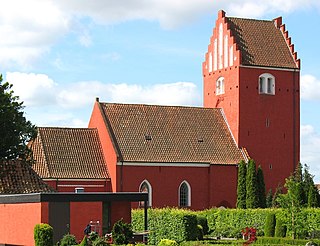
Nørre Alslev is a town with a population of 2,369 on the northern end of the island of Falster in south Denmark. It belongs to Guldborgsund municipality in Region Sjælland.

Nykøbing Falster is a city on the island of Falster in southern Denmark. It has a population of 16,927. Including the satellite town Sundby on the Lolland side, with a population of 3,178, the total population is 20,105.
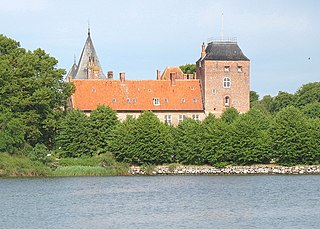
Nysted is a town in Guldborgsund Municipality in Region Zealand on the southeastern coast of the island of Lolland in south Denmark. Nysted is located on the southern coast of Lolland, and has a population of 1,284.

Sakskøbing, previously spelled Sakskjøbing, is a town on the island of Lolland in south Denmark. It has a population of 4,590. Until 1 January 2007 it was the seat of the former Sakskøbing Municipality, and is now situated in Guldborgsund Municipality in Region Sjælland.

Falster is an island in south-eastern Denmark with an area of 486.2 km2 (187.7 sq mi) and 43,398 inhabitants as of 1 January 2010. Located in the Kattegat, Belts and Sound area, it is part of Region Zealand and is administered by Guldborgsund Municipality. Falster includes Denmark's southernmost point, Gedser Odde, near Gedser.
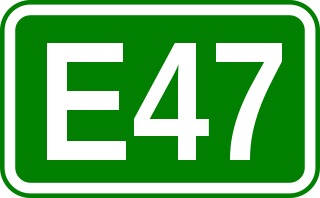
European route E47 is a road connecting Lübeck in Germany to Helsingborg in Sweden via the Danish capital, Copenhagen. It is also known as the Vogelfluglinie (German) or Fugleflugtslinjen (Danish). The road is of motorway standard all the way except for 28 km (17 mi) in Germany and 6 km of city roads in Helsingør; there are also two ferry connections.

Guldborgsund Municipality is a kommune in the Region Sjælland of Denmark, created on 1 January 2007 from six (6) former municipalities on the two islands Lolland in the west and Falster in the east bordering the Guldborgsund strait. It covers an area of 903.15 km2 (2013) and has a total population of 60,231. Its neighboring municipalities are Lolland to the west and Vordingborg to the north. Its administrative seat is in the town of Nykøbing Falster. Its mayor as of 1 January 2022 is Simon Hansen, representing the Social Democrats.

Lolland Municipality is a kommune on the island of Lolland in the Region Sjælland of Denmark. According to Municipal And Regional Key Figures (www.noegletal.dk) it covers a total area of 885.40 km2 and has a population of 39,632. The western part of Guldborgsund Municipality, the southernmost in Denmark, occupies the eastern part of the island (Østlolland).

Guldborgsund is the strait between the Danish islands of Lolland and Falster. It connects Smålandsfarvandet in the north with the Bay of Mecklenburg in the south. The strait is about 30 kilometers long; its breadth varies from 150 meters at Guldborg to 6 kilometer south of Nykøbing Falster. It is navigable for craft of up to 6 metres draught in its northern part and is used for commercial traffic to Nykøbing Falster. The southern part is much shallower with a minimum depth of approximately 2 metres, and can only be used by yachts and other small craft.
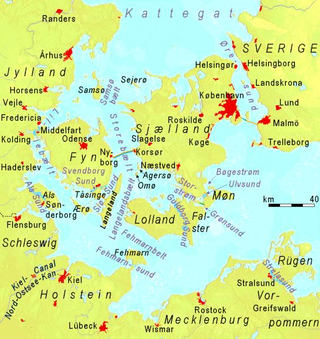
The Danish straits are the straits connecting the Baltic Sea to the North Sea through the Kattegat and Skagerrak. Historically, the Danish straits were internal waterways of Denmark; however, following territorial losses, Øresund and Fehmarn Belt are now shared with Sweden and Germany, while the Great Belt and the Little Belt have remained Danish territorial waters. The Copenhagen Convention of 1857 made all the Danish straits open to commercial shipping. The straits have generally been regarded as an international waterway.

The King Frederik IX bridge is a combined road and railway bridge carrying the Danish national road 9 as well as Sydbanen and Lollandsbanen railway lines across the Guldborgsund strait between the islands of Falster and Lolland in Denmark. It joins the larger part of the city of Nykøbing on Falster with the smaller part of the town on Lolland. The rail link is a part of the railway section of the Fugleflugtslinjen transport corridor between Copenhagen, Denmark and Hamburg, Germany.
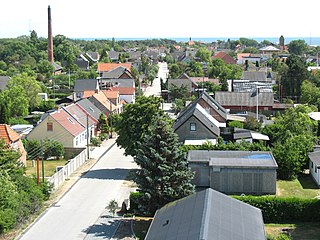
Gedser is a town at the southern tip of the Danish island of Falster in the Guldborgsund Municipality in Sjælland region. It is the southernmost town in Denmark, and also the southernmost point of Scandinavia and the Nordic countries. The town has a population of 659. It is an important port town on the Baltic Sea.

Klintholm Havn is a fishing village and a popular tourist resort on the south coast of Møn, an island in Vordingborg Municipality, southeastern Denmark. As of 1 January 2012, the population is 201.

Middelaldercentret is an experimental living history archaeological open-air museum in Denmark, which depicts the Middle Ages in the Denmark of the late 14th and early 15th centuries. It is located in Sundby Lolland, some 4 km northwest of the centre of Nykøbing Falster on the waterfront of Guldborgsund.

Lolland is the fourth largest island of Denmark, with an area of 1,243 km2 (480 sq mi). Located in the Kattegat, Belts and Sund area, it is part of Region Sjælland. As of 1 January 2022, it has 57,618 inhabitants. Lolland is closely connected to the island of Falster to its east. The locality of Sundby forms a cross-island urban area with Nykøbing Falster, the largest conurbation partially on Lolland. The most populated settlement on Lolland proper is Nakskov.

Sydhavsøerne, sometimes also referred to simply as Lolland-Falster from the two largest islands, is an informal but common term used in Danish to refer to the archipelago just south of Zealand, Denmark's largest island where its capital Copenhagen is located. Part of the Baltic Sea, the term covers Lolland, Falster and Møn as well as the numerous smaller islands of the surrounding straits, fjords and waters.

Hesnæs is a little fishing village located 12 kilometres (7.5 mi) southeast of Stubbekøbing on the Danish island of Falster. Its distance from Copenhagen is 125.4 km. It is best known for its thatched, straw-clad houses, not found elsewhere in Denmark.

Kettinge is a village and parish in southeastern Lolland, Denmark. It belongs to Guldborgsund Municipality, in Region Zealand. As of 2023 the village has a population of 506.

Torkilstrup Windmill is a post mill south of the village of Torkilstrup on the Danish island of Falster. Dating from 1743, it is one of the country's few post mills which still stand on their original site. It was listed in the Danish registry of protected buildings and places in 1959.
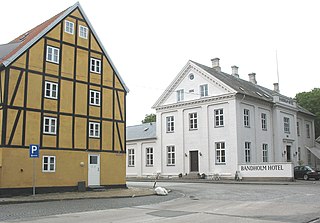
Bandholm is a small port town and parish on the coast of northern Lolland, Region Zealand, Denmark. On 1 January 2023 it had a population of 457, and is located to the northwest of Knuthenborg Safari Park and Maribo. From Bandholm there is ferry service to Askø and rail link to Maribo, 8 km (5.0 mi) north of Maribo. Stokkemarke is its west and Østofte Parish forms its southwest border. It is served by Bandholm Station. The Maribo-to-Bandholm rail branch is operated by the Museumsbanen Maribo-Bandholm as a preserved railway.






















